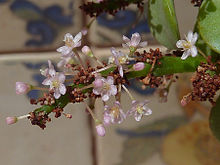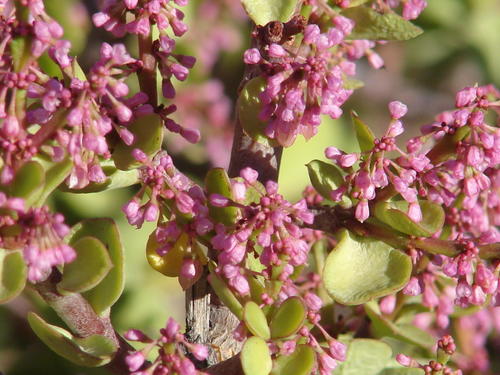Elephant bush
Search
Wikipedia
| Portulacaria afra | |
|---|---|

| |

| |
|
Scientific classification | |
| Kingdom: | Plantae |
| Clade: | Tracheophytes |
| Clade: | Angiosperms |
| Clade: | Eudicots |
| Order: | Caryophyllales |
| Family: | Didiereaceae |
| Genus: | Portulacaria |
| Species: |
P. afra
|
| Binomial name | |
|
Portulacaria afra | |
Portulacaria afra (known as elephant bush, dwarf jade plant, porkbush, purslane tree and spekboom in Afrikaans) is a small-leaved succulent plant found in South Africa. These succulents commonly have a reddish stem and leaves that are green, but also a variegated cultivar is often seen in cultivation. They are simple to care for and make easy houseplants for a sunny location. In frost-free regions they may be used in outdoor landscaping.
Description
It is a soft-wooded, semi-evergreen upright shrub or small tree, usually 2.5–4.5 metres (8–15 ft) tall. P. afra has smaller and rounder pads and more compact growth (shorter internodal spaces, down to 1.5 millimetres (0.059 in)). It is much hardier, faster growing, more loosely branched, and has more limber tapering branches than Crassula once established.[1]
The genus Portulacaria has been shown to be an outlier, relatively unrelated to the other genera in the family, which are all restricted to small ranges in the arid far west of Southern Africa.[2]
Distribution and habitat
It is very widespread in the east of South Africa (as well as Eswatini). In this moist climate, it is relatively rare, and tends to favour dryer rocky outcrops and slopes.
It is also found in much denser numbers in the dryer southern Cape. Here it occurs from the Little Karoo of the Western Cape, eastwards up until the thicket vegetation of the Eastern Cape.[3] Spekboom is found most prolifically in the Albany thickets, a woodland ecoregion, which locally is often called noorsveld, after the high number of succulent Euphorbia species, which are often called noors plants.[4] In these environments, P. afra is a source of food for multiple large herbivores, such as the Black rhinoceros and the African elephant.[5] Although it is not the primary food source for these animals, it still makes up a significant portion of their diet. [5]
Cultivation and uses
In the wilds of South Africa, large plants do survive the winter frosts by growing dense enough to provide their own natural cover. Drought-tolerant and fire-resistant, it will endure desert sun and heat once established, which the jade plant will not. P. afra is a common landscape plant in Phoenix, Arizona, and southern California, growing in USDA plant hardiness zones 9-11. Cuttings root very easily in most potting media.
Ornamental
It is popular as a specimen for bonsai,[6] and as a hardy xeriscaping plant. Several varieties exist - some bred in cultivation, others naturally occurring:[7]
- "Limpopo": A variety with much larger leaves. It is the natural form from the far north of the species' range.
- "Prostrata": A low-lying, decumbent form that is frequently used as a ground-cover.
- "Aurea": A compact, upright form with rounded leaves that go bright yellow in the sun.
- "Foliis variegatus": A variegated form.
- "Medio-picta": Variegated with a lighter centre.
Food source
In Southern Africa it is commonly eaten, usually as one component of a salad or a soup. It should not to be confused with the jade plant, which is mildly toxic.
P. afra is also used to feed livestock during periods of drought due to its succulent nature.[8] Most commonly used for cattle and goats, these plants also act as a supplemental source of water on top of their nutritional benefits for livestock.[8]
Medicinal
This is one of the many plants used as a traditional treatment for skin conditions used by people in rural areas that do not have easy access to more modern medicine.[9]
Carbon sequestration and ecological impact
P. afra is capable of either C3 or CAM carbon fixation, depending on factors such as the season and the age of the leaves.[3] In the dry season, it relies on the CAM pathway due to the lack of water, but when water is reintroduced, the plant quickly reverts to the C3 pathway in order to conserve energy.[10] The maturity of the leaf tissue also matters because younger tissue is unable to completely seal the stomata, making CAM impossible.[11] So while the older leaves are able to switch pathways based on the season and conditions, the younger leaves have to rely solely on the C3 pathway. It can sequester a maximum of 15.4 t CO2 ha−1yr−1.[12]
The South African government's Working for Ecosystems programme proposes restoring a million hectares (2.5 million acres) of P. afra thicket.[13][14] The addition of more spekboom into the environment can also help restore native species to areas where they no longer can grow.[15] P. afra has been shown to help create shade and add organic material into sandy soil, which allows for an environment more hospitable to young plants, thus helping restore populations of native species that were reduced by overgrazing and desertification.[15]
References
- ^ "Portulacaria afra". magiminiland.org (monograph). Pyramid Dancer. Retrieved 2011-01-20.
- ^ Bruyns, Peter V.; Oliveira-Neto, Mario; Melo-de-Pinna, Gladys Flavia; Klak, Cornelia (2014). "Phylogenetic relationships in the Didiereaceae with special reference to subfamily Portulacarioideae". Taxon. 63 (5): 1053–1064. doi:10.12705/635.36. ISSN 0040-0262.
- ^ a b Guralnick, Lonnie J.; Rorabaugh, Patricia A. & Hanscom, Zac, III (1984). "Seasonal shifts of photosynthesis in Portulacaria afra (L.) Jacq". Plant Physiology. 76 (3): 643–646. doi:10.1104/pp.76.3.643. PMC 1064348. PMID 16663899.
- ^ Becking, David. "Portulacaria afra | Tree SA". Retrieved 2019-07-21.
- ^ a b Paley, R. G. T.; Kerley, G. I. H. (1998-07-31). "The winter diet of elephant in Eastern Cape Subtropical Thicket, Addo Elephant National Park". Koedoe. 41 (1): 37–45. doi:10.4102/koedoe.v41i1.244. ISSN 2071-0771.
- ^ D'Cruz, Mark. "Ma-Ke Bonsai Care Guide for Portulacaria afra". Ma-Ke Bonsai. Retrieved 2021-02-04.
- ^ "Portulacaria afra". PlantZAfrica.com. Retrieved 2015-10-05.
- ^ a b Oakes, A.J. (December 1973). "Portulacaria afra Jacq.: A Potential Browse Plant". Economic Botany. 27 (4): 413–416. doi:10.1007/BF02860694. JSTOR 4253450. S2CID 45207710.
- ^ De Wet, Helene; Nciki, Sibongile; van Vuuren, Sandy F. (2013-07-19). "Medicinal plants used for the treatment of various skin disorders by a rural community in northern Maputaland, South Africa". Journal of Ethnobiology and Ethnomedicine. 9 (1): 51. doi:10.1186/1746-4269-9-51. ISSN 1746-4269. PMC 3724715. PMID 23870616.
- ^ Guralnick, Lonnie J.; Ting, Irwin P. (1987-10-01). "Physiological Changes in Portulacaria afra (L.) Jacq. during a Summer Drought and Rewatering". Plant Physiology. 85 (2): 481–486. doi:10.1104/pp.85.2.481. ISSN 0032-0889. PMC 1054282. PMID 16665724.
- ^ Guralnick, Lonnie J.; Rorabaugh, Patricia A.; Hanscom, Zac (1984-06-01). "Influence of Photoperiod and Leaf Age on Crassulacean Acid Metabolism in Portulacaria afra (L.) Jacq". Plant Physiology. 75 (2): 454–457. doi:10.1104/pp.75.2.454. ISSN 0032-0889. PMC 1066928. PMID 16663642.
- ^ Mills, Anthony J.; Cowling, Richard M. (2014). "How fast can carbon be sequestered when restoring degraded subtropical thicket?". Restoration Ecology. 22 (5): 571–573. doi:10.1111/rec.12117. ISSN 1061-2971.
- ^ Matthews, Alexander (3 February 2020). "How shrubs can help solve climate change". BBC Future. BBC. Retrieved 4 February 2020.
- ^ "South Africa's Environmental Programmes" (PDF). Retrieved 4 February 2020.
- ^ a b Panter, Bryce; Ruwanza, Sheunesu (June 2019). "Spekboom (Portulacaria afra) Planting in Degraded Thickets Improves Soil Properties and Vegetation Diversity". Ecological Restoration. 37 (2): 76–80. doi:10.3368/er.37.2.76. hdl:10019.1/111660. S2CID 181825218 – via EBSCO.
Further reading
- Paviour, Sarah-Jane (2014). Carbon sequestration and trading potential in semi-arid South Africa : A Karoo case study (MA thesis). Stellenbosch, Western Cape, South Africa: Stellenbosch University. hdl:10019.1/95794.
| Wikimedia Commons has media related to Portulacaria afra. |


